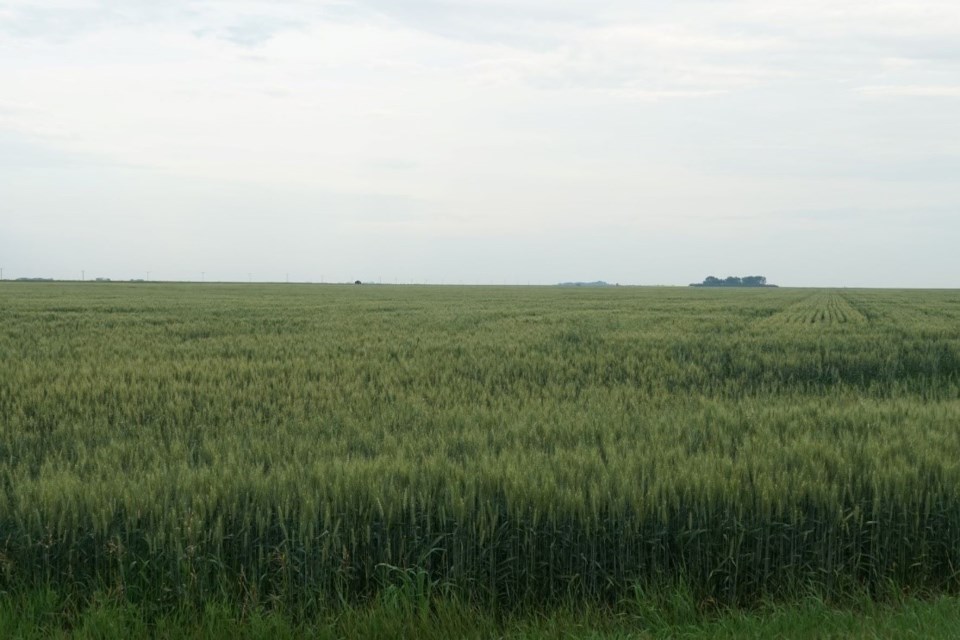With very little recent rainfall and a long stretch of hot temperatures, crops are rapidly advancing across the province. Twenty-seven per cent of fall cereals are in the dough maturity stage while 40 per cent of spring cereals are in the heading stage. Sixty per cent of canola and mustard are flowering and 38 per cent of pulse crops are in the podding stage.
East-Central Saskatchewan:
·Crop District 5 – Melville, Yorkton, Cupar, Kamsack, Foam Lake, Preeceville and Kelvington areas
·Crop District 6A – Lumsden, Craik, Watrous and Clavet areas
Like the majority of the province, the extended period of hot and dry weather has caused significant damage to crops in the east-central region. Crops such as canola that were flowering during the heat wave will be the most impacted, as heat blasting and heat stress symptoms are showing up in many fields. In some fields, there may be irreparable damage to yield potential as crops are quickly advancing. Many crops are thin, stunted and uneven with some prematurely ripening.Significant moisture is needed soon to replenish the topsoil moisture and to allow crops to properly fill.
While most of the region received small amounts of rain, the Wynyard area reported 21 mm, the Bulyea area 12 mm, the Kenaston area 10 mm, the Pelly area 4 mm, the Kelvington area 11 mm, the Lipton area 1 mm, the Kelliher area 5 mm, the Langenburg area 2 mm and the Allan area 3 mm.
Topsoil moisture conditions have sharply deteriorated across much of the region. Cropland topsoil moisture is rated as zero per cent surplus, 17 per cent adequate, 58 per cent short and 25 per cent very short. Hay and pasture land topsoil moisture is rated as zero per cent surplus, 10 per cent adequate, 45 per cent short and 45 per centvery short. Crop District 6A is reporting that 35 per centof the cropland and 67 per cent of the hay land and pasture is very short topsoil moisture at this time.
Haying continues with 15 per cent of the haycrop cut and 12 per cent baled or put into silage. Hay quality is rated as four per cent excellent, 62 per cent good, 23 per cent fair and 11 per cent poor. Yields are expected to be much less than normal, especially in those areas that did not receive large amounts of rain this spring. Pastures already have reduced carrying capacity and many water sources havealready dried up. Pasture conditions are currently rated as one per cent excellent, 12 per cent good, 28 per cent fair, 49 per cent poor and 10 per cent very poor.
The majority of crop damage this past week is due to lack of moisture, strong winds, gophers and insects such as grasshoppers.
Farmers are busy haying, applying fungicides ifwarranted, fixing equipment and hoping for rain.
Provincially, the continued lack of moisture combined with hot temperatures last week caused significant damage to many crops. Yield potential and crop quality will be impacted in many regions. Crops are stunted, thin, yellowing in colour and are prematurely drying down in many areas of the province due to the heat stress and lack of moisture. Significant rainfall is needed soon to allow crops to properly fill and avoid irreparable crop damage.
Topsoil moisture levels across the province have continued to deteriorate due to the extended period of hot, dry and windy weather. Cropland topsoil moisture is currently rated as zero per cent surplus, 18 per cent adequate, 51 per cent short and 31 per cent very short. Hay and pasture land topsoil moisture is rated as zero per cent surplus, 13 per cent adequate, 44 per cent short and 43 per cent very short.
Rainfall last week ranged from nil to 21 mm in the Wynyard, Rosetown and Porcupine Plain areas. Much of the province did not receive any rainfall, or received very small amounts that will not make a difference to topsoil moisture levels.
Despite the lack of growth on hay land, livestock producers continue with haying operations. Twenty-two per cent of hay crop is cut, while 14 per cent has been baled or put into silage. Hay quality is currently rated as six per cent excellent, 50 per cent good, 32 per cent fair and 12 per cent poor. Estimated yields so far are considerably lower than anticipated, with many producers indicating a second cut will not happen this year.
Pasture conditions continue to decline with the recent hot temperatures and are now rated as one per cent excellent, 11 per cent good, 32 per cent fair, 38 per cent poor and 18 per cent very poor.
Crop damage this past week is attributed to the extremely dry soil conditions, hot temperatures, strong winds and feeding from gophers and grasshoppers. Some producers have begun to spray for grasshoppers in pulse crops and hay stands.
Farmers are busy applying fungicides if warranted, moving cattle to market, scouting for pests, fixing equipment and hoping for rain.
We would like to remind producers the Farm Stress Line is available for support if you need it. The Farm Stress Line is a confidential service, available 24-hours-a-day, seven-days-a-week, toll-free at 1-800-667-4442. Calls are answered by Mobile Crisis Services Regina, a non-profit, community-based agency and there is no call display.
A complete, printable version of the Crop Report is available online at https://www.saskatchewan.ca/crop-report.
Follow the 2021 Crop Report on Twitter at @SKAgriculture.

